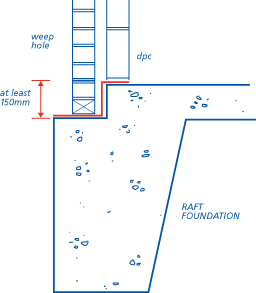A slow update, Coronavirus hampered some plans / materials and then my focus was taken up by other projects, but we're back in action today!
These were my original plans for the base, with a deeper slab and edge:
HOWEVER the groundworks guy went even deeper, but I only realised after the spoil had been removed.
In the end I tweaked the levels, dropped the height of the slab overall and stumped up £1200 for the concrete

.
Some decisions I made, looking at it with hindsight:
1) I went for a raft base over strip or trench footings for a few reasons:
- For me it was a simpler build, not much different to what I've built in the past:
- Get Diggerman to dig out
- I would do the shuttering
- Concrete delivery would level it also
- Arrange brickie
- I fit the roof
- Done
- There was a simple plan to follow in the NHBC guidelines: https://www.diynot.com/diy/media/nhbc-standards-for-detatched-garages.104936/
- The cost wasn't much different (with a raft, I could do more of the labour myself)
The first concrete company said I was mad buying all that concrete. He turned up and wouldn't do it!
I went back to the drawing board, thinking I'd been stupid. Another post on here suggested a trench foundation too. Was I being daft?
I reminded myself of the NHBC diagram and was satisfied I wasn't going totally off piste.
I did the sums. Yes there was £1200 of concrete, but a trench foundation wasn't all that different once I'd costed materials AND labour, given the point I was already at (with plenty of earth already dug out).
If I was starting from scratch again, I'd look more closely at a trench foundation and save money on spoil removal however.
2) I went for structural fibres over steel mesh
This was part of the attraction of a raft base. With structural fibres in the concrete, it would be way stronger than needed and idiot proof. Just pour and level.
Steel mesh would cost about the same as the fibres (which were +£250 I think), plus my time. There would be a lot of wasted steel because of the sheet size Vs. base size. Plus the trip hazard of walking on the mesh when pouring, getting access to the back corners whilst it's under the wet concrete.
As it happens, getting the fibres was the hard bit! 10 years ago, the only chap I rang for a concrete project offered to level it, and suggested steel fibres instead of mesh. Great!
It turned out later that this guy (no longer trading) was a bit of a unicorn. The guys I rang who would lay the concrete wouldn't do fibres. The guys who do fibres wouldn't lay it. I wanted to use a volumetric "barrowmix" type service, because the volume of the raft shape was hard to estimate and with readymix you're knackered if you order too little, but charged for disposal if you order too much (And still have to pay for the concrete they take back!)
I also found out that steel fibres in concrete are no longer a "thing". People got them stuck in hands and knees etc. and they stopped them. The few that still do it use plastic fibres now (like Adfil Durus fibres).
In the end I found a company that would help. It was readymix, he wouldn't level, but he would do the fibres I wanted.
I planned to barrow and lay the concrete with a friend. The concrete company let me know that it would be 160 wheelbarrow loads! In the end we worked out he could get access to use his chute.
The guy was great, everything went in smoothly, including my ground anchor for the motorbike:
Today, at last, the brickie has started. He'll be done in a few days, then I start the roof:
For anyone interested, I'm keeping a list of my costs here:
https://docs.google.com/spreadsheets/d/1U3apm6e2xhuOABcER070wuY6LCjfqIJ5pRNlXIdGgIs/edit?usp=sharing

























